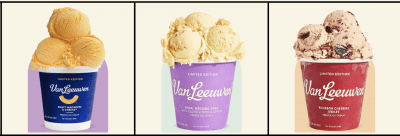Run the World: How These 8 Women Entrepreneurs Are Changing Their Industries
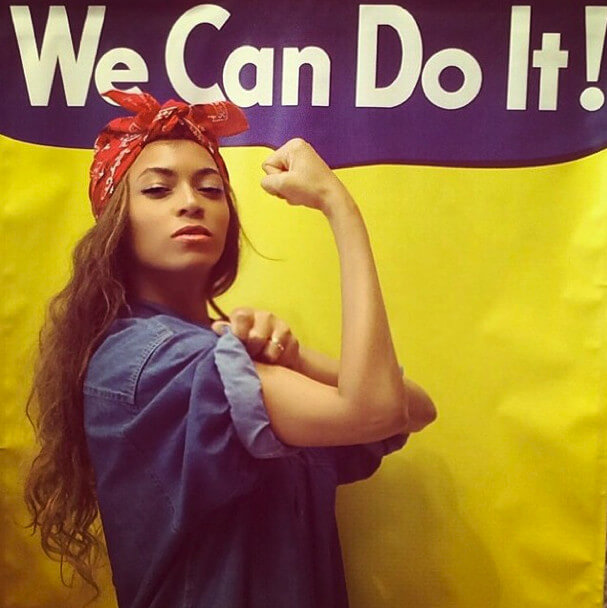
Beyonce showing who runs the world. (Women.)
While it is undeniable that in recent years women have been taking over leadership roles in businesses and have an emerging presence in once primarily male-dominated fields, slowly chipping away at the still-existent corporate glass ceiling, it’s also true that women continue to average just 78 cents to the man’s dollar (much less for black and Latino women). But despite these inequalities—or maybe because of them—we figured that it would be a good idea to focus on some of the many women who have achieved amazing things in their chosen fields—specifically those living and working in Brooklyn. As per a CrunchBase analysis, about 28 percent of Brooklyn-based startups are founded by at least one woman founder, meaning that the borough is leading the country with the highest percentage of female-founded startups and companies. The number is a part of a larger study that notes that woman founder roles as a whole have been on an upward path since 2009.
And so, even though there’s still a ways to go in achieving gender (and racial and ethnic and more!) equality, we thought it was fitting to give credit where it’s due, and acknowledge some of the many women who are changing the very fabric of our frankly patriarchal society. So here are eight women changing business as we know it, and, really, here’s to all the women getting shit done everywhere.
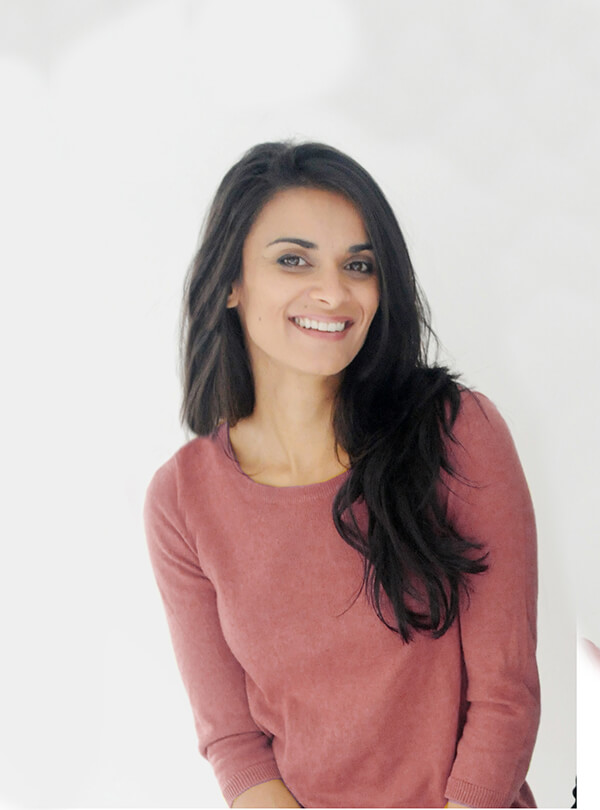

Photo provided by Toymail
Gauri Nanda, Founder of Nanda Home & Co-founder of Toymail
Back in 2004, Gauri Nanda launched Nanda Home with the intention of reinventing everyday technologies in our homes. The former Apple Computer Inc. design engineer had been interested in design, but realized that technology could be a catalyst for stronger designs. “I read a book called The Design of Everyday Things, and from then on I began to look at things in the world as design problems that could be solved—anything from objects like alarm clocks that don’t do a very good job of getting you out of bed, to roads and how their design ultimately impacts the prevalence of car accidents,” said Nanda. The University of Michigan and MIT Media Lab graduate had been a chronic oversleeper who, tired of waking up late for class, decided to “fix” the way we wake up, by creating an alarm clock that runs away when you hit snooze. “The idea for a clock with personality that’s purpose was to force me out of bed just sort of popped into my head as I was laying [in bed],” Nanda said. “A few years previously I had had kittens that woke me up every day by pouncing on me. They probably served as some of the inspiration.” With an inkling that she was on to something, Nanda stored the idea in her “ideas notes” unbeknownst to her that she would be revisiting the idea in a few months in the form of an assignment for her industrial design intelligence class. At the MIT Media Lab, she had the opportunity to put thought to paper by creating a proof-of-concept mock that went over well with her peers. And by sticking a ‘y’ at the end of ‘clock’, Clocky was born. The class project would go to change Nanda’s life overnight once she posted it on the MIT Course website. “Clocky became viral, and people were calling my office non-stop asking where they could buy one,” she said. “I had a huge opportunity on my hands and I’m not one to turn down an opportunity.” It was during this period when Nanda got in contact with a woman from Frog Design who gave her some advice that she had been wanting to hear, “‘I couldn’t afford Frog, but it doesn’t matter, I could do it myself.’ That’s what I needed to decide to go it alone.”
Clocky would go on to get national recognition, being featured in publications like the New York Times and Inc. But not content on being just a one-hit wonder, Nanda teamed up with fellow University of Michigan graduate and best friend, Audry Hill to create Toymail Co. nine years later. The company was created as a way for Nanda to remain connected with Hill’s three children, while removing the isolation factor that comes with too much screen time. “I have small children in my life that I’m close to, and I realized there is no messaging system with kids, even though it is a big part of our lives,” Nanda said. “The passion of what we’re doing with Toymail is all about finding [communication] options for kids that doesn’t involve a screen.” The screenless toys let you record and send messages to your kids, your siblings’ kids or your friends’ kids through the power of ingenuity, six mailbox shaped characters and quirky filtered voices. “When you give objects personality, you get better connections,” Nanda said. What are Nanda’s favorite characters? Snort and Rochester, of course. As for the future of Toymail and Clocky, Nanda has a few things up her sleeve. “Next year is the 10-year anniversary of Clocky,” Nanda said, “so expect to see some new things.”
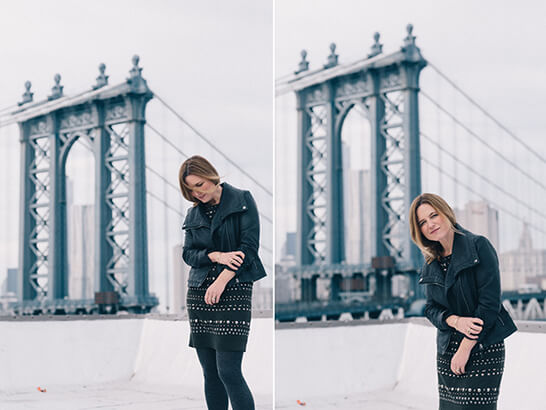

Photo by Andrew Shepherd
Lexy Funk: Co-founder and CEO of Brooklyn Industries
Lexy Funk has been ahead of the game since she was a 16-year-old attending Wesleyan University. She had skipped a grade due to a minor technicality with the school systems: She’s pretty damn smart. Moving to Geneva, Switzerland from London at 11, Funk consistently tested higher than her age group. This “technicality” only helped her start Brooklyn Industries a couple years sooner. But not before starting three other companies in the late 90s: Crypto Inc., Two Tsunami Productions, and Would You Rather Go for a Walk or Stay at Home and Watch TV? But nothing would have the profound impact that Brooklyn Industries would when it opened in 2000. The initial thought of the company formed four years earlier, when Vahap Avsar, Funk’s husband and cofounder, dragged a discarded Marlboro billboard that had been hanging outside their studio window out of a factory dumpster to create their first product, recycled billboard messenger bags. “It comes from the artistic mentality,” Funk said. “You don’t have money, so you have to use what is in the environment.” The two had been living in Williamsburg as struggling artists, where a 26-year-old Funk was a photographer. “At the time, Brooklyn wasn’t cool or the hippest place. But there was a lot opportunity to start something fresh,” she said. “It was gritty and had a lot of possibility. Plus, there was an artistic and industrial environment to start a business because the community [was] a place for interesting writers, artists and designers.”
Fueled by an artistic spirit to reuse the things that the rest of the world deemed to be undesirable, and living off the mantra of LIVE, WORK, CREATE, Funk was able to exchange those days of dumpster-diving for a new wave clothing company with 16 stores spread across the country, in cities like Portland, Chicago, and of course, Brooklyn. But not forgetting her old life, Funk has designed her stores to be eco-friendly. So besides creating merchandise from either upcycled or organic material, Funk has structured her stores to be sustainable. This means furnishing the stores with repurposed and vintage furniture and powering them with wind energy. As for their clothes and accessories, their aim is to be adaptive to an ever-changing environment, which Funk notes has allowed them to survive in retail as long as they have. “I liked the aspect that we were making something that wasn’t for a specific consumer. You can sell to many people instead of one person. Interact with the community directly instead of funneling it. You create an environment and an ethos,” Funk said. “It’s fascinating to me.” Coming from a family of entrepreneurs who believed in taking risk and independent, Funk grew up with a “lean in” mentality that kept her from doing the norm. “I never thought that I would ever take a normal path,” she said. “I came from a family that was doing things slightly different.” That mentality kept Funk from buying into cheaper and inorganic methods of producing their products. “Constantly, we are looking for what we can improve on. This year what can we do? A third of our product is organic, how can we make more than a third, and then how can we make it 100 percent,” she said. “[We] focus on what we want to do, and not the mentality that everyone has in their head about Brooklyn because we might wake up one day and Brooklyn is isn’t cool. Then what?” Their efforts to reduce their carbon imprint led to Brooklyn Industries and Funk to be honored by ConEdison Solutions as Green Power Pioneers. The achievement wasn’t the first and definitely won’t be the last achievement, since Ernst & Young would later dub the artist turned entrepreneur as the 2010 Metro New York Entrepreneur of the Year.
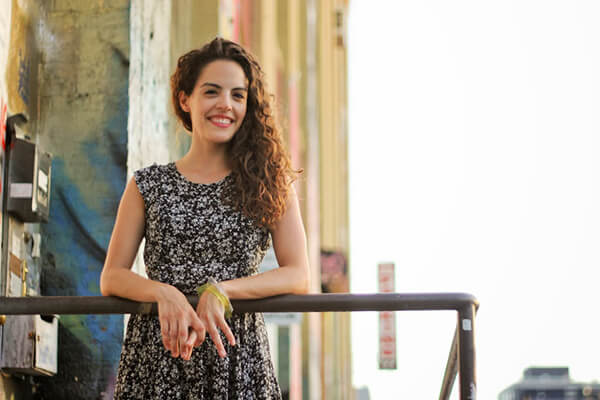

Photo by Jane Hu
Daniela Perdomo: CEO & Co-founder of goTenna
Growing up in São Paulo, Brazil, Daniela Perdomo is no stranger to how crippling social disparities can be, especially in times of crisis. “I’ve grown up acutely aware of the issues that affect the developed world, even though I was lucky enough to be raised with a tremendous amount of privilege,” she said. “It wasn’t until college [when I] took a sociology class that I learned the language with which to speak of something I innately knew and cared deeply about: structural inequality. I think technology becomes truly revolutionary when it’s accessible to all kinds of people–not just people in Silicon Valley or New York City.” The sociocultural and political effects of technology sparked her interest in working with tech world, but when her brother Jorge pitched her an idea in the summer of 2012 that would solve the frustration of not being able to get service at events, like music festivals, she wasn’t completely sold. Perdomo had already been working in tech startups since 2008, after leaving her first postgrad job as a writer for the LA Times, and was in the beginning phase of creating a mobile app called TripTonight with a friend. And though they both had an affinity towards technology, her brother’s idea failed to satisfy her sociocultural and political interests.
That was before Hurricane Sandy ambushed the East Coast, knocking out power and cell towers, leaving the New Yorker in the dark both physically and figuratively. Unable to check up on people who were located in zones that were completely disconnected from the rest of the world, Perdomo realized a less trivial need for her brother’s original idea. “The most important two questions to ask about technology are: who controls and who benefits? I don’t think enough technologists have such considerations,” Perdomo said. Walking away from her career and the app, Perdomo and her brother began working on a technology that would enable off-grid communication, without the need of central connectivity, thus goTenna, the product and company was founded. Though it currently benefits those in the United States who can afford a smartphone, Perdomo hopes that by 2017 goTenna will extend their reach so that those people who need it the most will have access to their technology. “The potential impact of goTenna could be relatively small–say, we solve a problem for niche groups, be they hikers or travelers or disaster-relief workers. That would be enough. In fact, building this product which solved a problem my co-founder and I had is enough, in a way, but there’s also the potential for goTenna to be part of a larger movement to decentralize communication,” Perdomo said. “Redefining the ability to communicate according to your need for it, rather than your ability to access it is a big idea.” Though it has only been around for three years, goTenna has been banned in Slovakia, which Perdomo proudly boasts by framing it on her wall. “I was extremely validated, honestly! We aren’t selling outside the United States at the moment, and the fact that there’s a 300,000€ fine for using goTenna in Slovakia is kind of amazing,” she said. “It means our story really has spread far and wide.”
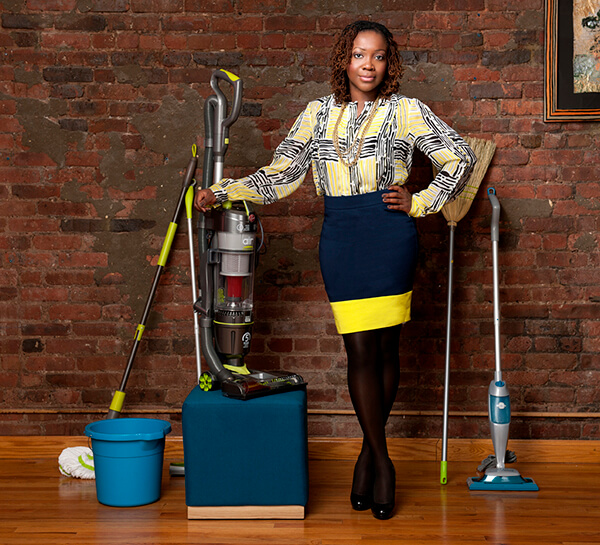

Photo provided by Greenhouse Eco-Cleaning
Saudia Davis: Founder and CEO of GreenHouse Eco-Cleaning
While most teenagers were aspiring to be doctors, musicians, and writers, Saudia Davis had her eyes set to something more gratifying and self-rewarding: owning a business. She comes from a line of independent women who taught her how to be self-reliant. Her paternal grandmother in particular, whom she spent a portion of childhood growing up with, had owned a business in Jamaica, so owning one felt destined. “I remember in high school it being inevitable,” Davis said. “I specifically remember being in high school and a friend of mine saying, ‘yeah I’m going to be an executive at AT&T” and I thought she was crazy. ‘Why would you want to do that? Why wouldn’t you want to have your own business?’ I thought her idea was insane.”
It wasn’t until Davis got older that she realized that her friend’s path was one that everyone seemed to follow, and that she was the outlier. But Davis didn’t start immediately; she didn’t have an idea, only the assertion that it was in her crosshairs. So after graduating from Bowdoin College with a bachelors in science, she became a movie publicist for celebrities like Matt Dillon, Reese Witherspoon, and Daniel Day Lewis (who would eventually be the one to encourage to start her business). It wasn’t until the passing of her maternal grandmother, who had lost both parents at a young age and didn’t have a high school education, had turned to cleaning as a way to sustain her life in the States, that Davis started to revaluate her surroundings and her decisions.
“When my grandmother passed, we had a lot of conversations with the doctors and there was a lot of her inhaling harsh cleaning chemicals, and that became a running theme for us. As a family, we became much more conscientious,” Davis said. At the same time, I remember watching Oprah (I think Oprah is always a key player in great success stories) [and] she did a show on jobs that no one wanted to do. One was cleaning gutter and drains, but it kind of reinforced the idea that there was a need for cleaning and healthy eco-cleaning.” So backed with an idea and support of family and friends, Davis started putting up flyers and cleaning on the weekends, while continuing to work fulltime until she got enough money to start GreenHouse Eco-Cleaning. “I would be doing a red carpet on a Monday, and cleaning someone’s toilet on a Tuesday,” she said. As an organic commercial and residential cleaning company whose aim is create a “green, toxic-free environment in every room of your home” that benefits the clients, cleaners and the overall environment. From lemon oils to baking soda, each of their natural concoctions are safer to use and generate the same cleanliness as chemical-based products. “What was shocking was when I cleaned out all toxic products, how much my body was alerting me when something was not so great,” Davis said. “I didn’t have to read the label. I would have a physical reaction, which I still have to this day.”
So her advice to the bleach fanatics: Switch to vinegar. The smell might be unsavory, but it’s a safe alternative. What had started as a way to encourage healthy living, slowly started to reshape it something deeper when Davis realized the impact her company had on their workers, many of whom had bigger socio-economical challenges and relied on each paycheck to survive, like her maternal grandmother did. “It was like ‘OMG I have this ability to take from people who are well off and give it to people who are really in need, and somehow create a balance in the world.’ That was something I wasn’t banking on,” Davis said. “It is a gift to be able to do that and to see that impact on people in the world. Especially on people that nobody wanted to bank on. No one wanted to give a chance at seeing them really grow and evolve and develop, to me its just a blessing, for me it’s the why, why I do it and the why we do it the way we do.”


Photo by LeStudio NYC
Kathy Larchian: Co-founder of Pensa
When the prolific minds of Kathy Larchian, Marco Perry, and Mark Prommel first started working together back in 1999, it was destined that they would start their own creative firm. So it wasn’t a surprise when the three founded Pensa six years later. Armed with a bachelor of arts in anthropology and Spanish, and a master of business administration in management, organizational behavior and entrepreneurship from New York University, and a history of managing creative firms since 1994, you can say that Larchian is the glue that holds the company together. She had been working in design management 10 years beforehand, paid her way through graduate school, and helped her design firm where she operated as the business manger, turn a 20 person staff to one that employed more than 65 people. But it wasn’t until she got her MBA that she approached Perry, her husband who had his own design and engineering business, with a partnership. “[I] said, ‘we can do more together.’ He agreed.”
As a powerhouse that makes things happen, Larchian had no reservations when started the company. “Starting a business is like jumping off of a cliff with a backpack of parts and building your airplane on the way down,” she said. “You believe in your own and your team’s forethought, you believe in your skills, and you pay attention to your environment the whole way. It is not a leap of faith. It is trust, focus, and hard work.” From working out of their apartment to eventually setting a concrete home base in Dumbo, the design and invention firm is situated in the Brooklyn Tech Triangle, a creative and technical hub that includes DUMBO, Downtown, and the Brooklyn Navy Yard. Driven by a desire to improve the world with great design and clever invention, Pensa works with other companies to create solutions by implementing new gadgets or re-designing household objects, so that they become simple and more practical for everyday life.
“I believed and still believe that great design improves the quality of life,” Larchian said. “The designers and I came at the same problem with completely different skill sets. That’s what makes a creative business tick.” Their clientele includes goTenna, where their team helped build the startups’ brand, and designed and engineered the device. As a businessperson, Larchian says her biggest motivator is people. This realization came when she was attending a staff party back when she was managing a product design firm. The attendees were scrutinizing and questioning generic, everyday objects as a way to understand the purpose it had in relation to everyday life. I realized that these designers and engineers were going to improve my experience with the objects around me,” Larchian said. “People motivated them. I had incredible respect for that. Still do. Because people motivate me.” Even powerhouses have hard days, and that’s when Larchian turns to The Free Design’s 1967 song. “When a day gets more complicated than expected I like to hear Kites Are Fun, she said, “puts things into perspective.”
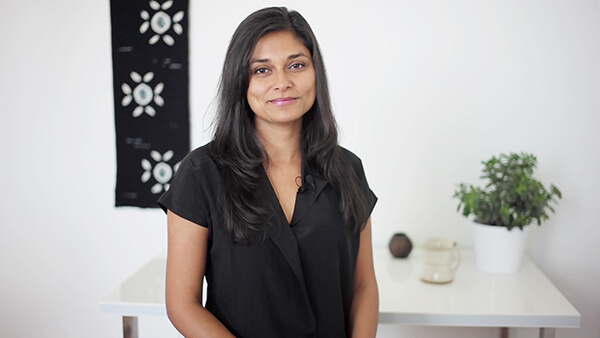

Photo provided by Madesmith
Sumeera Rasul: Founder of Madesmith
Sumeera Rasul inherited her appreciation for old-fashioned craftsmanship from her father, who introduced Rasul at an early age to the artistry of local artisans and makers in Pakistan and Afghanistan through the family’s manufacturing and international trade business, and her maternal grandmother who taught embroidery and sewing to underprivileged girls in garment vocation schools. But it was the imperfection of handmade textiles that peaked Rasul’s interest in the stories of the artist behind the craft, and would later be the inspiration for Rasul and her sister Nadia to not only revive their family business in 2007 with Dia Living, but eventually found Madesmith.“I think textiles really encapsulate a culture better than anything else, better than food better than anything else. They survive, they survive longer than any other artifact to really depict a culture,” Rasul said. “And we spent a lot of time in our youth sitting next to artisans and people making these things, we both connected to the families and our family provided a way for them to make a living.”
So in 2012, after 16 years marketing, branding, and advertising for companies like Apple, Nike and Starbucks and reviving the family’s business, Rasul teamed up with her sister again, and tacked on another company in an already extensive résumé, by founding Madesmith, an online marketplace that showcases products and the stories of the artisans, makers, and designers who create sustainable, handmade items. At the time, Nadia had been working fulltime for the nonprofit Breakthrough, but Rasul had a different plan for the two of them. “I made my sister quit her job,” Rasul said. “My mom was like ‘she has a job’ but I was like ‘yes, but we’re going to be entrepreneurs.’” Unlike Dia Living, the revival of her father’s business that became a channel for Rasul to add to her already extensive collection of Japanese, Indian, and Peruvian textiles, and that currently exists as a sentimental keepsake to his legacy, Madesmith was created to simplify the hassle of finding trustworthy products by answering the question: where can I find a site where everything is neatly curated to my taste? “When we started it was really hard to find things because Etsy had it where you had to sift through a lot of stuff,” Rasul said. “[And] I think people don’t have the time. I think that the biggest thing now is about curation [and] finding tastemakers you can identify with. I’m like that. I don’t have a lot of time, and I just want to go someplace where I can trust their taste, I can trust what’s behind the stuff they are selling me, and find out more about the thing and the maker. I crave that.”
So from the Minneapolis three-person team that extract their ingredients straight from the beehive to the longtime LA pals who repurpose lumber for handcrafted longboards, Rasul and her team at Madesmith truly believe that everyone and everything has a story to tell. Beyond being an outlet for artisans to display their products, the company provides business courses aimed to help these individuals on the business side of their trade in Madesmith Academy. “It’s about the people first,” Rasul said. “I learned that from my father, he used to always say, because he came from a wealthy family [but] lost it all, so he was like, money comes and goes, so its really about the people.” Through transparency and connectivity, Rasul hopes to not only shape a more conscious consumer, one who is looking for an experience they can cherish, and not another purchase they will later discard but to create emotional bonds in her family business, one that has become richer than blood ties.
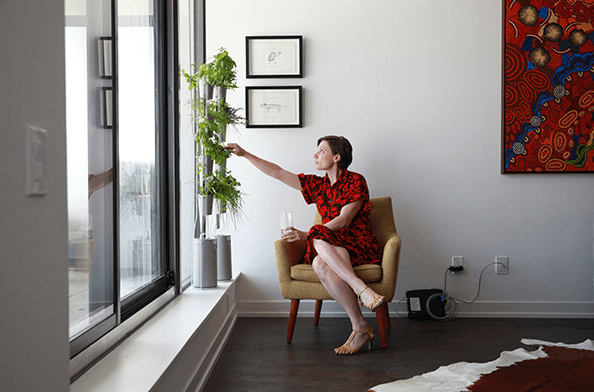

Photo provided by Windowfarms
Britta Riley: Founder of Windowfarms
Why should farm to plate have a middleman, when you could grow your own fruits and vegetables within steps of your own table? Even if that table is squeezed between a queen-sized bed and that spur-of-the-moment IKEA couch of your 600-square-foot apartment in Gowanus. For Britta Riley, it was a 24-unit multi-family building that could barely fit five people inside at once that made her long for a relationship with nature. Having grown up on a ranch, the magnetism of New York turned to a “sense of being trapped indoors” not because one had to close the kitchen door just to enter the bathroom but because of the city’s shortage of fresh and non-pathetic looking fruits and vegetables. “I had a notion of what veggies, herbs, and greens should taste like, since I had grown a substantial vegetable garden growing up in Texas and, even during college, when I had access to a yard,” she said. “I didn’t realize until much later how much of a natural experience eating vegetables is for me. Biting into a dish that has just the right crunch, the earthiness and brightness that only vegetables bring, it’s not unlike taking in an epic view from a mountaintop in a way.” So after reading a New York Times article by Michael Pollan one winter, and backed with insight on how NASA uses hydroponics, Riley decided to retake control of her food experience and open the opportunity to individuals who were “rednecks, [like herself], who moved to the city” and those “who were maybe a little scared of dirt” by starting Windowfarms as an open research project that started to attract some international attention.
“As the project began to attract tens of thousands of followers online from far flung places like Helsinki, Nairobi, and Hong Kong, each designing for similar and yet slightly different goals, I started to understand that this was not just an NYC thing,” Riley said. “Billions of people in cities all around the world are feeling cooped up, nature starved, and wanted to try out this fascinating experience of growing food for themselves, fitting it into their in tiny city spaces as well.” As a social enterprise, Riley is helping city dwellers get a taste of what homegrown food, cultivated from their own windowsills is like by giving them the resources to establish their own urbanized farms. “What we’re doing is what NASA or a large corporation would call R&D, or research and development. But what we call it is R&D-I-Y, or research and develop it yourself,” Riley said in her 2011 TEDTalk. And if you know anything about TED, you know that it’s a hub where the world’s best movers, shakers, and thinkers converge. Although the response has been overly positive, there are haters criticizing the urban agriculture movement, to which Riley responds with dignity. “There’s more behind the movement than the end result of stuffing one’s face,” she said. “We’re past the age of sustainability to ease our guilty consciences, we are actually yearning for a new relationship with nature, with all its lessons and complexity, to have it personally present day-to-day in our modern lives.”
What sets Riley and her work apart is that Windowfarms is an open source community that is truly invested in supporting the betterment of human life by giving them the power and a choice in how they grow and consume food. What you’ll find in her windowsill: Sishito peppers, cherry tomatoes, lavender, pea shoots, and edible flowers, but most importantly, Tulsi, aka the Holy Basil. “It’s a sacred Hindu plant relative to basil used in Ayurvedic medicine that has a bit more of an aromatic peppery kick similar to arugula,” she said. “We use it all day, in smoothies, salads, teas, and stir fry dishes.”
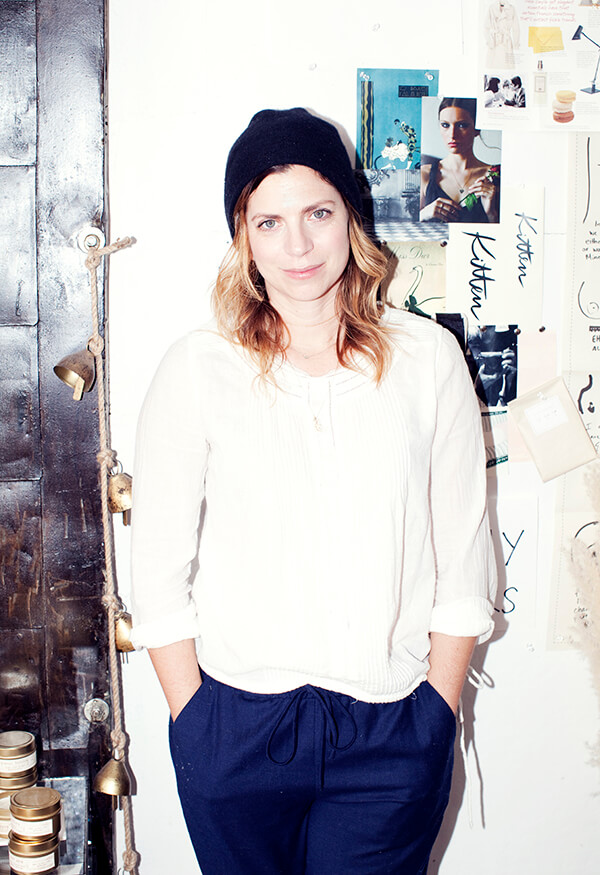

Photo by Erik Tanner
Rony Vardi: Founder and Owner of Catbird
It’s hard to think of a recent jewelry trend that Rony Vardi and her gal pals (and one guy) at Catbird didn’t influence. The coveted layered knuckle ring trend that grabbed the attention of Lena Dunham back in 2014 has been credited to the New Jerseyan turned Brooklynite. “I’ve always considered my business growth to be very organic and natural—but not accidental,” Vardi says. “Ring stacking started because I personally love small, delicate, easy-to-wear jewelry and it’s pretty natural to stack it to make it personal. I was doing it myself, the girls in the store were as well—and the models and actresses that live here and shop at Catbird started doing the same. They would buy one piece for themselves and return over years to build their stacks.” Vardi didn’t always follow a creative path. She initially went to school as a pre-med, but later pursued graphic design and became a seamstress before moving to New York.
“From the beginning, I discovered that I loved both buying and selling jewelry. It’s so personal and generally no one is in a grumpy mood when buying jewelry,” said Vardi. Catbird started as an evolving project that would continually mold to satisfy a local need that Vardi felt had been overlooked in the borough. “I lived in a sort of neglected area of Williamsburg where there was really very little retail (except some great thrift stores),” she said. “I thought it would be nice to have a place where you could buy yourself, say, a fancy candle after a long day at work. Or a Mother’s Day present.” So backed with $16,000, a stack of credit cards with a zero percent interest rate and some sound advice, Vardi opened Catbird in 2004, but it was still a far cry from the internationally adored shop that it’s become today.
“It felt like the right time to be my own boss but that was the extent of my plan,” Vardi said. “In the beginning, I sold a variety of things—clothing, elbow patches, shoes, [and] small accessories. Over time, the jewelry was what stood out as my strong suit, as well as what my customers were coming back for. After moving into our extremely small Bedford Avenue storefront, it also became the best fit, literally.” Unlike most jewelry lines, all of Catbird’s jewelry line is currently made in their studio that’s walking distance from the shop by their team of 17 jewelers, a huge shift from the days of producing pieces in kitchen of one their jewelers’ home. “It allows us to produce pieces through conscious, slow design so that we’re only keeping what we truly love on the shelf,” Vardi said. “Walking into Catbird, you won’t see seasonal trends or markdowns. We also try to keep a variety of pieces at different price points in the store, so that most anyone can walk in and feel that they’ve found something they love.” Vardi loves the independency in a woman who buys her own jewelry as a way to create “instant heirlooms” that could “be re-discovered and passed forward.” As of last year, Catbird expanded their reach to include the wedding demographic by opening the Annex for an intimate wedding ring shopping experience. However, Vardi and her team don’t plan on taking a break from shaping their image. “Next is a website re-launch that will allow us to bring more ease into our online experience,” she said. “Plus we are continuously creating and discovering. Non-stop.” But the true end goal for the innovator is to maintain good vibes.
You might also like 
















